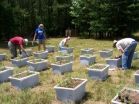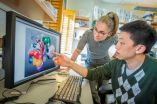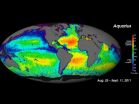(Press-News.org) DURHAM, N.C. -- In experiments mimicking a natural environment, Duke University researchers have demonstrated that the silver nanoparticles used in many consumer products can have an adverse effect on plants and microorganisms.
Fifty days after scientists applied a single low dose of silver nanoparticles, the experimental environments produced about a third less biomass in some plants and microbes.
These preliminary findings are important, the researchers said, because little is known about the environmental effects of silver nanoparticles, which are found in textiles, clothing, children's toys and pacifiers, disinfectants and toothpaste.
"No one really knows what the effects of these particles are in the environment," said Benjamin Colman, a post-doctoral fellow in Duke's biology department and a member of the Center for the Environmental Implications of Nanotechnology (CEINT).
"We're trying to come up with the data that can be used to help regulators determine the risks to the environment from silver nanoparticle exposures," Colman said. CEINT's research is funded by the National Science Foundation and the Environmental Protection Agency
Previous studies have involved high concentrations of the nanoparticles in a laboratory setting, which the researchers point out, doesn't represent "real-world" conditions.
"Results from laboratory studies are difficult to extrapolate to ecosystems, where exposures likely will be at low concentrations and there is a diversity of organisms," Colman said.
Silver nanoparticles are used in consumer products because they can kill bacteria, inhibiting unwanted odors. They work through a variety of mechanisms, including generating free radicals of oxygen which can cause DNA damage to microbial membranes without harming human cells.
The main route by which these particles enter the environment is as a by-product of sewage treatment plants. The nanoparticles are too small to be filtered out, so they and other materials end up in the resulting wastewater treatment "sludge," which is then spread on the land surface as a fertilizer.
For their studies, the researchers created mesocosms, which are small, man-made structures containing different plants and microorganisms meant to represent the environment. They applied sludge with low doses of silver nanoparticles in some of the mesocosms, then compared plants and microorganisms from treated and untreated mesocosms after 50 days.
The study appeared online Feb. 27 in the journal PLOS One.
The researchers found that one of the plants studied, a common annual grass known as Microstegium vimeneum, had 32 percent less biomass in the mesocosms treated with the nanoparticles. Microbes were also affected by the nanoparticles, Colman said. One enzyme associated with helping microbes deal with external stresses was 52 percent less active, while another enzyme that helps regulate processes within the cell was 27 percent less active. The overall biomass of the microbes was also 35 percent lower, he said.
"Our field studies show adverse responses of plants and microorganisms following a single low dose of silver nanoparticles applied by a sewage biosolid," Colman said. "An estimated 60 percent of the average 5.6 million tons of biosolids produced each year is applied to the land for various reasons, and this practice represents an important and understudied route of exposure of natural ecosystems to engineered nanoparticles."
"Our results show that silver nanoparticles in the biosolids, added at concentrations that would be expected, caused ecosystem-level impacts," Colman said. "Specifically, the nanoparticles led to an increase in nitrous oxide fluxes, changes in microbial community composition, biomass, and extracellular enzyme activity, as well as species-specific effects on the above-ground vegetation."
The researchers plan to continue to study longer-term effects of silver nanoparticles and to examine another ubiquitous nanoparticle – titanium dioxide.
INFORMATION:
The rest of the team were Duke's Christina Arnaout, Claudia Gunsch, Curtis Richardson, Emily Bernhardt, Bonnie McGill and Justin Wright; Sarah Anciaux of Coe College, Iowa; Michael Hochella and Bojeong Kim of Virginia Tech University; Gregory Lowry and Brian C. Reinsch of Carnegie Mellon University, Pittsburgh; Jason Unrine at the University of Kentucky; and Liyan Yin of Wuhan Botanical Garden, China.
Silver nanoparticles may adversely affect environment
2013-02-28
ELSE PRESS RELEASES FROM THIS DATE:
Research explores factors that impact adolescent mental health
2013-02-28
Research indicates that half of all lifetime cases of mental illness begin by age 14, well before adulthood. Three new studies investigate the cognitive, genetic and environmental factors that may contribute to mental health disorders in adolescence. The studies are published in Psychological Science and Clinical Psychological Science, journals of the Association for Psychological Science.
Social-Information-Processing Patterns Mediate the Impact of Preventive Intervention on Adolescent Antisocial Behavior
Kenneth A. Dodge, Jennifer Godwin, and The Conduct Problems ...
NuSTAR helps solve riddle of black hole spin
2013-02-28
An international team including Lawrence Livermore National Laboratory scientists has definitively measured the spin rate of a supermassive black hole for the first time.
The findings, made by the two X-ray space observatories, NASA's Nuclear Spectroscopic Telescope Array (NuSTAR) and the European Space Agency's XMM-Newton, solve a long-standing debate about similar measurements in other black holes and will lead to a better understanding of how black holes and galaxies evolve.
"We can trace matter as it swirls into a black hole using X-rays emitted from regions very ...
First grade math skills set foundation for later math ability
2013-02-28
Children who failed to acquire a basic math skill in first grade scored far behind their peers by seventh grade on a test of the mathematical abilities needed to function in adult life, according to researchers supported by the National Institutes of Health.
The basic math skill, number system knowledge, is the ability to relate a quantity to the numerical symbol that represents it, and to manipulate quantities and make calculations. This skill is the basis for all other mathematics abilities, including those necessary for functioning as an adult member of society, a ...
A game plan for climate change
2013-02-28
Researchers have successfully piloted a process that enables natural resource managers to take action to conserve particular wildlife, plants and ecosystems as climate changes.
The Adaptation for Conservation Targets (ACT) framework is a practical approach to assessing how future changes in air and water temperatures, precipitation, stream flows, snowpack, and other environmental conditions might affect natural resources. ACT enables scientists and managers to work hand-in-hand to consider how management actions may need to be adjusted to address those impacts.
"As ...
Changing shape makes chemotherapy drugs better at targeting cancer cells
2013-02-28
(Santa Barbara, Calif. –) Bioengineering researchers at University of California, Santa Barbara have found that changing the shape of chemotherapy drug nanoparticles from spherical to rod-shaped made them up to 10,000 times more effective at specifically targeting and delivering anti-cancer drugs to breast cancer cells.
Their findings could have a game-changing impact on the effectiveness of anti-cancer therapies and reducing the side effects of chemotherapy, according to the researchers. Results of their study were published recently in Proceedings of the National Academy ...
Retailers should re-size maternity wear for women throughout their pregnancies, MU study finds
2013-02-28
COLUMBIA, Mo. — Fashion retailers have seen an increase in demand for maternity wear in recent years, as sales for maternity clothing have increased while overall women's apparel sales have declined. Currently, most retailers produce maternity wear using a standardized size chart that begins with women in their seventh month of pregnancy. Retailers produce garments for women who are earlier in their terms by adjusting the sizes smaller proportionally based on the standardized chart. In a recent study, University of Missouri researcher MyungHee Sohn, an assistant professor ...
Reading the human genome
2013-02-28
Researchers with the U.S. Department of Energy (DOE)'s Lawrence Berkeley National Laboratory (Berkeley Lab) have achieved a major advance in understanding how genetic information is transcribed from DNA to RNA by providing the first step-by-step look at the biomolecular machinery that reads the human genome.
"We've provided a series of snapshots that shows how the genome is read one gene at a time," says biophysicist Eva Nogales who led this research. "For the genetic code to be transcribed into messenger RNA, the DNA double helix has to be opened and the strand of gene ...
Workstation design improvements for drone operators may reduce costs & mishaps, researchers suggest
2013-02-28
The U.S. Department of Defense reports that drone accidents in which personnel or aircraft are damaged or destroyed occur 50 times more often than mishaps involving human-operated aircraft. The U.S. Marines and Army reported 43 mishaps that involved human factors issues associated with drone ground control workstations and technology during 2006−2007.
Human factors/ergonomics (HF/E) researchers Qaisar Waraich, Thomas Mazzuchi, Shahram Sarkani, and David F. Rico suggest that multimillion-dollar drone losses might be prevented if long-established and broadly applied ...
Protein balance key in preventing cancer
2013-02-28
PHILADELPHIA, PA (February 27, 2013)—Two proteins that scientists once thought carried out the same functions are actually antagonists of each other, and keeping them in balance is key to preventing diseases such as cancer, according to new findings published in the February 25 issue of Developmental Cell by scientists at Fox Chase Cancer Center. The results suggest that new compounds could fight cancer by targeting the pathways responsible for maintaining the proper balance between the proteins.
"It's our job now to understand how we can intervene therapeutically in ...
NASA's Aquarius sees salty shifts
2013-02-28
The colorful images chronicle the seasonal stirrings of our salty world: Pulses of freshwater gush from the Amazon River's mouth; an invisible seam divides the salty Arabian Sea from the fresher waters of the Bay of Bengal; a large patch of freshwater appears in the eastern tropical Pacific in the winter. These and other changes in ocean salinity patterns are revealed by the first full year of surface salinity data captured by NASA's Aquarius instrument.
"With a bit more than a year of data, we are seeing some surprising patterns, especially in the tropics," said Aquarius ...




